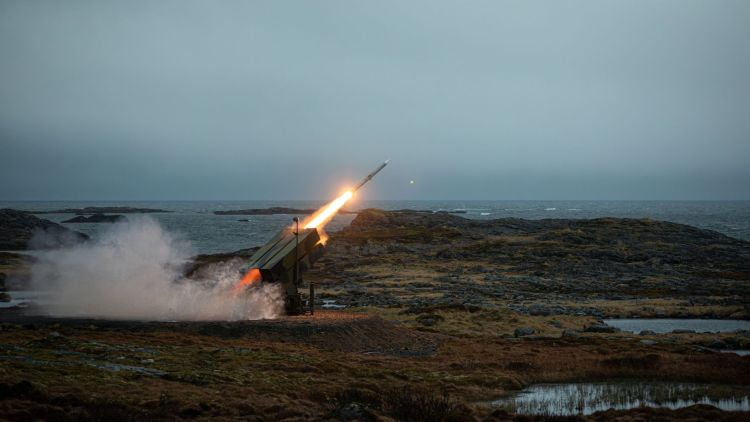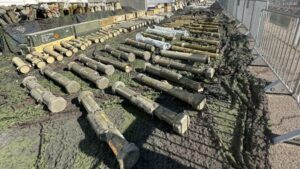The following piece first appeared on Warrior Maven, a Military Content Group member website.
Taiwan is now slated to acquire large amounts of Ukraine-tested, US-built air defenses, called National Advanced Surface-to-Air Missile Systems (NASAMS), a development that could greatly change the character and scope of the Chinese threat to the island.
An October 26 memo from the Pentagon’s Defense Security Cooperation Agency announced a potential $2 billion sale to Taiwan, including NASAMS and Advanced Medium-Range Air-to-Air Missiles (AMRAAM). Should Taiwan receive the ER – extended range – AMRAAM variant, its fighter jets would be well-positioned to counter or slow down any large-scale Chinese air campaign.
An interesting essay in VOA News quotes Taiwanese experts explaining that the arrival of these NASAMS will fill a critical gap between what Taiwan currently has… Stingers for short-range air defense and Patriot missiles for longer-range missile defense. The arrival of a mid-range defensive capability for Taiwan would indeed add new dimensions to the island’s ability to counter a rapid surprise Chinese attack.
A Patriot missile can defend areas out to 45 miles or so, about 15 miles below the boundary of the earth’s atmosphere, and a Stinger can hit closer-in threats such as at ranges out to 5 miles. NASAMS, therefore, brings the ability to target those in-between targets up to distances of 31 miles.
Beyond simple range questions, however, NASAMS bring additional new advantages potentially unprecedented for Taiwan; modern air defense systems are increasingly capable of networking with one another through digital connections to quickly share target detail as an air threat passes from one aperture to another, a scenario which often results in the loss of a target track.
Newer air defenses are also more precise and better able to maintain a target “lock” on attacking aircraft from a wider range of frequencies.
The following piece first appeared on Warrior Maven, a Military Content Group member website.
Taiwan is now slated to acquire large amounts of Ukraine-tested, US-built air defenses, called National Advanced Surface-to-Air Missile Systems (NASAMS), a development that could greatly change the character and scope of the Chinese threat to the island.
An October 26 memo from the Pentagon’s Defense Security Cooperation Agency announced a potential $2 billion sale to Taiwan, including NASAMS and Advanced Medium-Range Air-to-Air Missiles (AMRAAM). Should Taiwan receive the ER – extended range – AMRAAM variant, its fighter jets would be well-positioned to counter or slow down any large-scale Chinese air campaign.
An interesting essay in VOA News quotes Taiwanese experts explaining that the arrival of these NASAMS will fill a critical gap between what Taiwan currently has… Stingers for short-range air defense and Patriot missiles for longer-range missile defense. The arrival of a mid-range defensive capability for Taiwan would indeed add new dimensions to the island’s ability to counter a rapid surprise Chinese attack.
A Patriot missile can defend areas out to 45 miles or so, about 15 miles below the boundary of the earth’s atmosphere, and a Stinger can hit closer-in threats such as at ranges out to 5 miles. NASAMS, therefore, brings the ability to target those in-between targets up to distances of 31 miles.
Beyond simple range questions, however, NASAMS bring additional new advantages potentially unprecedented for Taiwan; modern air defense systems are increasingly capable of networking with one another through digital connections to quickly share target detail as an air threat passes from one aperture to another, a scenario which often results in the loss of a target track.
Newer air defenses are also more precise and better able to maintain a target “lock” on attacking aircraft from a wider range of frequencies.
As has been shown in Ukraine, NASAMS are simply able to “deny” airspace to enemy aircraft by making it far too dangerous for aircraft to enter, especially in the case of 4th-generation aircraft. Years ago at the beginning of the Ukraine war, Pentagon officials explained that Russian pilots were “risk averse” and not able to near NASAMS covered areas.
This means Taiwan will get a battle-tested air defense system which is extremely effective, particularly against 4th-generation aircraft which lack the advantages of stealth. The existence of NASAMS on the island of Taiwan could make it extremely difficult for 4th-generation Chinese aircraft such as a J-10, J-11 or J-15 to attack Taiwan from the air, leaving hopes or prospects of air attack to China’s land-launched 5th-generation J-20.
However, advanced air defenses are increasing the ability to track some 5th-generation aircraft, at least according to Russian news media claims about its S-400s and S-500s. While growing, China’s fleet of J-20s is much smaller than its 4th-generation fighter force.



